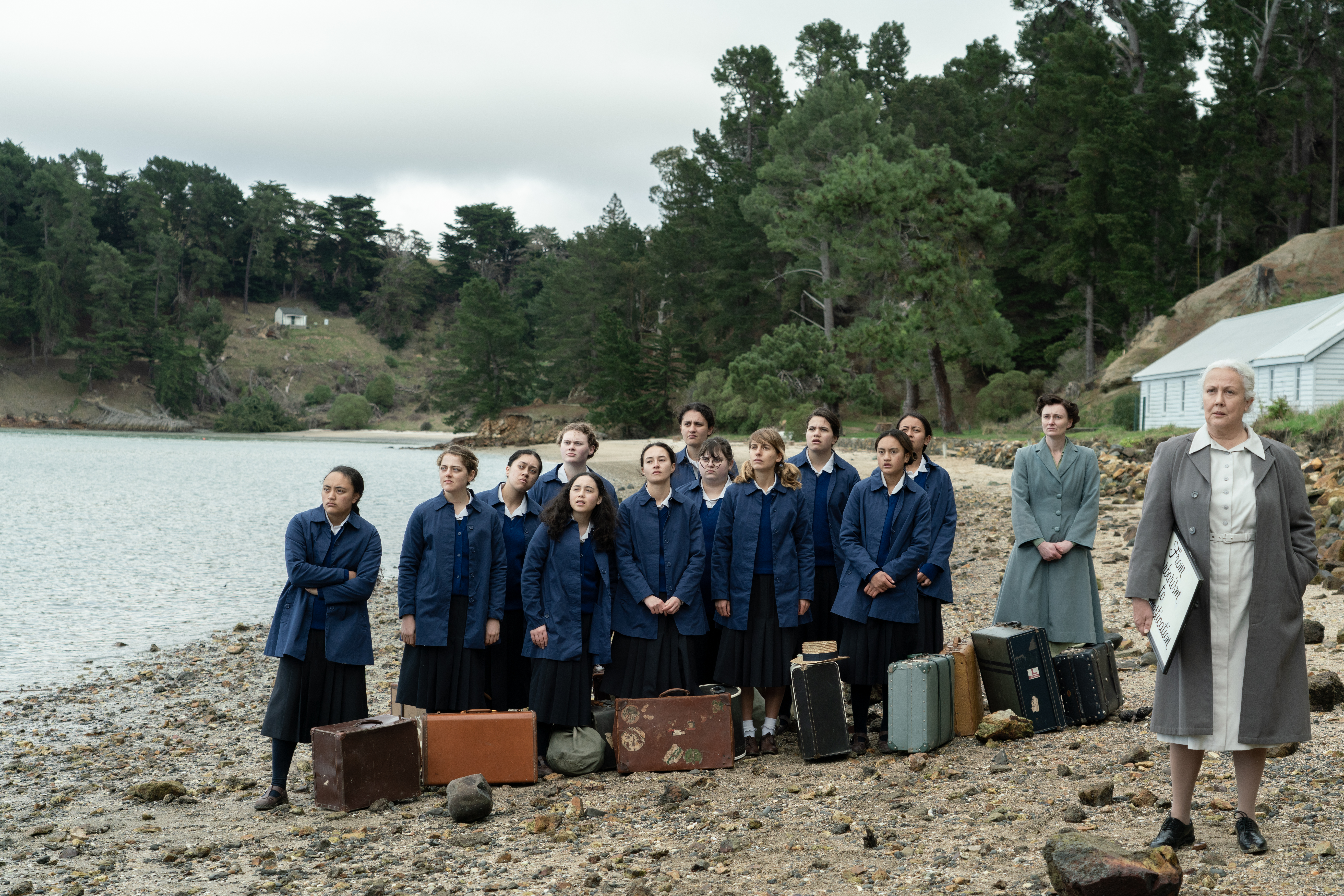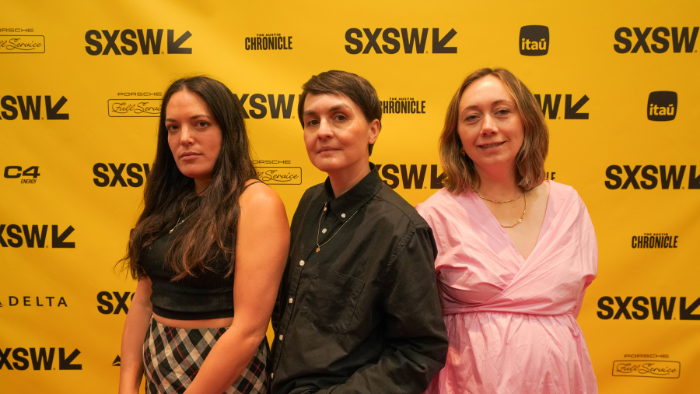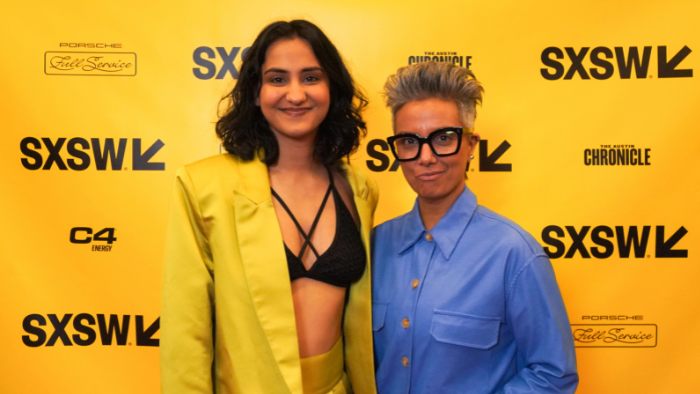The gall of a teenage girl can be a behemoth of a thing — stubborn, melodramatic, hard-to-handle and, sometimes, exactly what one needs to survive. Director Josephine Stewart-Te Whiu’s directorial feature debut “We Were Dangerous” takes place in 1954 Aotearoa, New Zealand, where Nellie (Erana James), Daisy (Manaia Hall) and Lou (Nathalie Morris) are forced to attend a residential reform school. These institutions were established by colonialist New Zealand, historically severing students from their native heritage and performing unethical medical experiments on them.
Nellie (James) and Daisy (Hall) are two Māori girls who were dealt a bad hand, with unfair and uncontrollable circumstances leading to a, (quite tame), pastry shop robbery, an arrest and eventual enrollment in a school for “troubled” girls. There, they meet Lou (Morris), a rich white student whose parents have wiped their hands clean after learning about her queerness. In a flash, the three become an unshakeable trio, no matter how hard the matron (Rima Te Wiata) tries to squander their bond.
Character Media sat down with director Stewart-Te Whiu, writer Maddie Dai and producer Morgan Waru to discuss the making and themes of the film and why we all could use more art that champions the teenage girl spirit.

Character Media: We all have different roles here. How did you feel, Josephine, being at the helm of this project as director?
Josephine Stewart-Te Whiu: It was terrifying not going to lie. I have previously done short films or collaborated on long format. You definitely get a bit of “Imposter Syndrome.” You [also] think you know more than you do, [and] enter into it with blind confidence that you’re gonna be fine and everything’s gonna be amazing.
CM: It’s big, and then at some point, you realize you are doing what you did before.
JSW: It’s just a little bit more extended. But it’s my dream film to tell. Because I’m all about female stories. I started as an actor, and I moved behind the performance space into creating work. I was frustrated at a lack of multidimensional roles for women and like, “Fine. If no one’s gonna do this, I’ll do it!” Yeah, the script was my dream.
CM: For the script, did you do a lot of research? What was that like?
Maddie Dai: I did because I was [genuinely] interested. I read a book about people imprisoned on islands in New Zealand and they had details—there wasn’t enough for them to do, so they’d spend tons of time polishing shells or whatever. Research helps you add a little texture that makes things feel more lived in, but I also was interested in the movements around eugenics in New Zealand and the history of our equivalent of residential schools — state care facilities — and interested in the treatment of women and the moral panic around them as sexual beings.
CM: It intersected in a way that turned out into something really good. What got you interested in the production side of things?
Morgan Waru: We were lucky the producers on the film, Polly Fryer, Carthew Neal, [and] myself, had come across Maddie as a blossoming Kiwi writer.
We were sent her script and thought it was like nothing I’d ever read before. We just really wanted to make it. We took that momentum, spent a bit more time developing it and we’re lucky enough that Jos really fell in love with it too. Then we went into production quite quickly. It was a really fantastic film, feeling that momentum and the casting came together wonderfully.
CM: The cast is great.
JSW: We scoured New Zealand for an island, [and] had three shoot days on the actual island. The helicopter shot that you see [in the film] that’s the island that we were on. Then the rest of it, we actually cheated a little bit around the peninsula. It was just more accessible. But, we did scout the country. It was hard. We were looking for an island that could be period. So it still felt like it was in the 1950s.
CM: Sometimes, I fall in love with a scene and wonder what it’s like to be behind the camera. What was your favorite scene to direct?
JSW: I loved directing Rima, the matron. She’s so much fun. There’s a real play that happens.
But, my favorite scene to direct was the three girls lying in the hut on the ground. We have this really beautiful top shot. Me and my cinematographer love top shots. There’s like heaps of them in the film. I loved that scene because I had let Erana know, “Just relax and play, the three of you.” And I was like, “When you’re ready, I want you to start the scene, but I’m not going to call action or anything. We’re going to do it really quietly.” And they were improvising, and then Erana started the dialogue and the script, but then Manaia, who plays Daisy, started coming out [with stuff] that wasn’t in the script, and I was like, “This is really good.” Because she’s so natural, and it’s hard to get kids to be authentic.

CM: She’s lovely. That was my favorite scene. I was like, “Daisy. That’s my girl.”
You talked about doing research. Was it hard to parse through that stuff? This movie tackles heavy topics, and in some ways, you’re also personally connected.
JSW: It was hard. My personal connection is my dad. He was raised in those state care schools in New Zealand. That was a little bit heartbreaking reading through and talking to him [about] his experiences. And then we were talking to other women who had been in girls’ state care schools. It’s hard reading those stories, but those people who went through it are still alive. The saddest part is talking to them, but also, on the flip side, they shared great stories about the friendships and the bonds that were created in those environments. That solidified this exploration that we were doing: “There’s some really hard stuff happening, but there’s still joy and light in the film and for these characters, and that’s true to their lived experience as well.”
MD: There has recently been, in New Zealand, a big inquiry and uncovering of systemic, historic, ongoing abuses in these sorts of state care facilities, and I had been reading a bunch of these documents, and it’s just like one harrowing thing after another. When we talked with people who had been in the facilities, what was illuminating was the range of perspectives and memories. Some were moments of great levity and joy and camaraderie and being like, “That bitch!” We were informed by those lived experiences.
MW: It was enlightening despite it being a heavy topic, to meet and talk to real people and realize [they] aren’t just reduced to being defined by their trauma, and that they are also just as defined by their joy and their ability to have meaningful friendships, and their memories of being cheeky and brats
CM: I love how you brought up the friendship because that is the central point of the movie — the three girls. Did you guys pour any of your life experience and friendship experience into this movie at all? Did you connect to it personally while working on it?
JSW: That just organically happens. In New Zealand, it’s really common to be separated by gender, and you have boys’ schools and girls’ schools once you hit high school. That’s still happening. It’s very English. We were colonized, remember, by them. That aspect is there for all of us.
And in terms of the friendship, there’s a real power in female friendships. It’s a sisterhood. People like to label that as catty or someone’s being bitchy or bullying and those sorts of stories are told over and over again, but there’s never anything really refreshing and I was like, “Let’s reflect back on what it’s [actually] like.”
CM: Because it’s not always cattiness. Maybe you’re having a disagreement and you and your friend have a little tiff.
JSW: Yeah! You do the puppy puddles. You’re all just, clambering on each other.
MD: I definitely felt that there were not [many] representations of teenagehood as I experienced it [in media]. I have two sisters, I’m the youngest. So definitely lots of those dynamics.
I do think it’s interesting that we’re three young women, just about to hit our prime, [laughs.] We were taking on the story about three young women, and there were moments [making] it where it felt like we were rallying against the system. We were the group, it reflects us back.
CM: Real life was paralleling the movie as it was being made! How does it feel having “We Were Dangerous” show at South by Southwest?
JSW: It’s f****** amazing. “Everything, Everywhere All at Once” premiered here. Like, come on. Obviously, we’re in a different theater today, [laughs.]That sort of thing. But still. It feels amazing to share this space.
MD: Also, I do think it’s interesting to have the world premiere in Texas at a time, in a place where questions of autonomy over women’s bodies feel so alive and regressive. South by Southwest as a festival has a reputation for being super young and irreverent and youthful and fun. And Austin [ as a city is] encapsulated. But to have that wider context amidst this festival, I was like, “Wow, [the film] landed in a place where it felt amazing for it to land.”
CM: You’re totally on the money there. Is there anyone you want to thank or shout out?
JSW: Everyone who worked on the film, it’s really humbling. I know you’ve got three of us in front of you right now, but there were a huge number of people [who] worked on this film.
CM: I saw! The credits go on and on and on. It’s crazy.
JSW: Yeah. All of them, every single one of those people, they gave up their time to help us tell our story. And our beautiful actors, I really wish they could have joined us here, and unfortunately they couldn’t, but I just adore those people. I’m so happy for them.
MW: I should thank my fellow producers because it was very much a team effort. Polly Fryer really produced on the ground—it was incredible. We wouldn’t have been able to make the film without the support of the executive producers: Emily Gotto, Bill Way, Elliot Whitton, Carthew Neal, and Taika Waititi.






